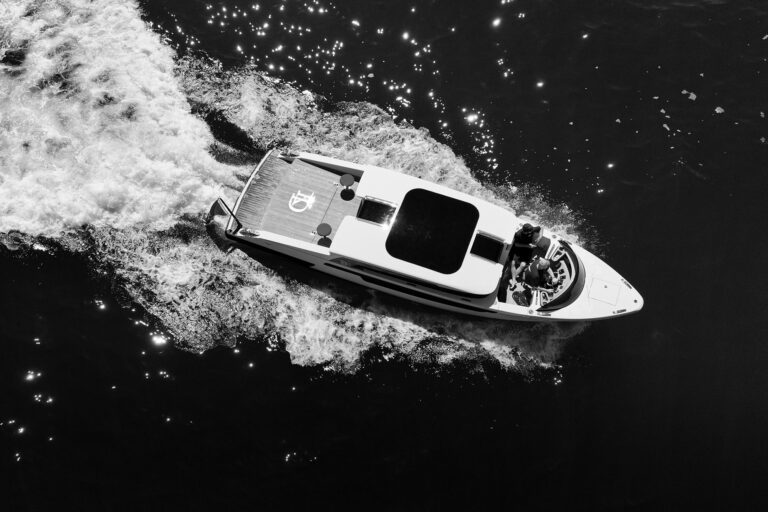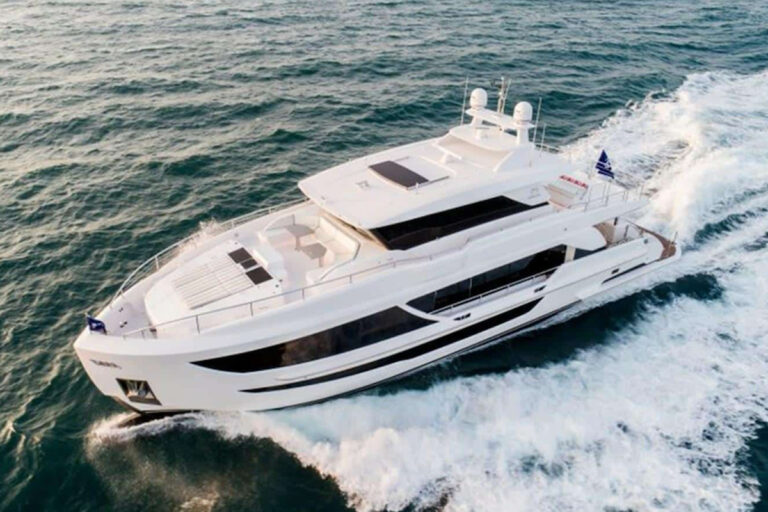My test of Furuno’s new NAVpilot-500, a self-learning, adaptive autopilot, recalled my long-forgotten first experience with a marine autopilot. The unit was a Bendix model that-in smooth water-could keep a boat fairly close to the selected magnetic heading by rotating the entire compass binnacle. Its “electronics consisted of a light bulb, a photosensor and some relays-no transistors or vacuum tubes. The Furuno NAVpilot-500, on the other hand, uses a powerful microprocessor and an advanced system that senses-with help from a companion GPS-your boat’s magnetic heading. It also “learns the boat on which it is installed, dynamically adjusting its operation in response to your yacht’s speed, trim and draft, as well as set and drift of the tide, wind and sea state. What a difference 40 years can make.
The NAVpilot-500 I tested was installed on High Frequency, a 24-foot Cobia center console belonging to HWH Electronics of St. Pete Beach, Florida. In addition to the autopilot, the boat was equipped with a full suite of Furuno NavNet equipment.
The autopilot’s flush- or trunion-mount control unit is dominated by an easy-to-read 4.6-inch, 160-by-160-pixel sunlight-viewable monochromatic display and a large “push to enter knob, which controls mode selection. Eight dedicated keys provide access to the NAVpilot-500’s setup and operating modes. The user interface is highly intuitive, an advantage that will be especially significant in the event the unit must be operated by an inexperienced crewmember or guest. The system performs an extensive self-check upon turn-on, including verification of information from the heading sensor and rudder-angle transducer. Any detected faults are displayed on the LCD for analysis and correction.
The unit’s operating choices include “standby and six primary steering modes: “automatic, “navigation, “turn, “remote, “dodge and a useful “advanced auto mode, accessible via a menu selection. We left the dock in standby, or manual, mode with the LCD displaying the boat’s heading to 0.1 degrees magnetic (true heading was available) and rudder angle in degrees to port or starboard. Pressing Auto transferred the helm to the autopilot. I made changes to the course by rotating the control knob and pressing the port and starboard control buttons, which are marked with arrows. The LCD conveyed selected heading, current heading and rudder position.
Though an autopilot generally has little trouble keeping a boat on a constant heading, wind or current can alter your intended course. The NAVpilot-500’s advanced auto mode ensures your boat proceeds directly to the visual reference point the helmsman specified when choosing the initial heading, an innovative and useful ability. The unit does this by automatically establishing a virtual GPS waypoint ahead of the boat, based on the heading in use when “advanced auto was selected. The autopilot then operates as if it were navigating to an infinitely distant waypoint, automatically compensating for the effects of wind and current. Any mariner experienced in visually navigating a narrow channel subject to cross winds or currents will delight in this capability.
The NAVpilot-500’s LCD presents information in one of four arrangements: two “normal displays, a data display and a graphic display made up of seven images. Each includes all information in use by the unit. The result is a very user-friendly interface, an attribute critical to an autopilot.
Autopilots are frequently operated in “nav mode, automatically tracking to a designated waypoint. Sometimes, though, the helmsman must interrupt this navigation mode to avoid an obstacle or another vessel. Re-engaging the nav mode can cause a radical change in the boat’s heading as the autopilot steers back to the original course. The NAVpilot-500 handles this by providing two programmable choices for resuming navigation to the waypoint after an off-track deviation. In “XTE, or cross-track error, mode, the autopilot alters your boat’s course to intercept the original track and proceed to the waypoint. In “course mode, it automatically computes a new route to the waypoint from the boat’s present position, avoiding a sharp change in heading.
Fishermen will be particularly impressed by the NAVpilot’s five pre-programmable turn maneuvers: orbit, spiral, cloverleaf and 180- and 360-degree turns to port or starboard. The unit’s “fishing mode allows three of these maneuvers-orbit to port, orbit to starboard and cloverleaf-to automatically engage when the boat reaches a designated waypoint. Any of these maneuvers may be selected manually, as well. In either orbit mode, the boat circles around the waypoint at a pre-programmed radius between 0.05 and 9.99 miles. In cloverleaf mode, the boat’s track follows a cloverleaf pattern within a pre-programmed range of similar dimension, continually re-crossing the designated waypoint. Spiral mode allows you to program both the radius of the spiral and the advance, or distance, between successive spirals. This is ideal for tracking a moving school of fish. Since all these maneuvers are intended primarily for use when fishing, a speed in excess of 10 knots will trigger an alert tone and summon a “too fast to fish message on the LCD. Used with care, the cloverleaf maneuver might also be helpful in a man-overboard situation.
In addition to navigating to a GPS waypoint, the NAVpilot-500 can navigate to a target designated on a connected radar or sonar display. In this mode, the boat’s course upon arrival at a waypoint can be programmed to orbit the point, proceed in a series of spirals toward the target (followed by orbiting the target) or follow a cloverleaf pattern centered on the target. We explored the unit’s ability to maintain a precise over-the-ground circular track in a moderate breeze with a substantial tidal stream just off the southeastern coast of Sanibel Island, Florida. The photo of the NavNet plotter tells the story well: The successive circles rapidly merged into one on-screen track as the autopilot “learned the sea and wind conditions.
To be successful, an autopilot’s control responses must match the characteristics of the boat on which it is installed and account for changing conditions. Autopilot operating parameters are usually preset by the manufacturer or programmed during initial sea trials. The NAVpilot-500, though, is different. It uses fuzzy logic to recognize and respond to the boat’s dynamic characteristics, progressively learning to optimize its control responses. It accumulates a library of speed-dependent control parameters that include rudder ratio, counter rudder and auto trim. The intelligence designed into the system is further illustrated by the unit’s “net towing mode, which automatically adjusts the trim setting to minimize deviation from course caused by the drag of a net.
In addition to this fully automatic learning mode, the operator can select “semi-auto, “manual-calm, “manual-moderate and “manual-rough settings. Based on my test, I feel that most users will prefer the auto mode, since it makes the most of the autopilot’s learning ability. Everything the NAVpilot-500 learns is stored in a non-volatile memory.
Regardless of other aspects of its design, an autopilot’s performance depends on the quality of information supplied by its heading sensor. The NAVpilot-500 accepts data from any NMEA 0183 heading source that provides information at a rate of 5 Hz or greater, or from Furuno’s PG-500 gyro-assisted magnetic flux gate. The SC-60 or SC-120 GPS compass may also serve as the heading source.
The NAVpilot-500 is a complex piece of gear, so plan to become familiar with the 82-page owner’s manual. The unit’s excellent simulations will help, but an in-depth understanding of what this device can do will become apparent only after some hours of on-the-water experience, as the autopilot learns the boat.
The NAVpilot-500 is an excellent autopilot that will see service on a wide range of boats, from the outboard-powered center console on which we tested it through large sportfishermen and motoryachts. Its ability to accept up to six identical FAP-5001 controls, or a mix of full control positions and handheld remote controls, will be particularly appreciated on large vessels, where multiple control stations are needed. Its suitability for sailboats would be enhanced by automatic tack, jibe and steer-to-apparent-wind modes, but you can’t have everything-at least not yet. Price: $2,995.
Contact: Furuno U.S.A. Inc., (360) 834-9300; www.furunousa.com









